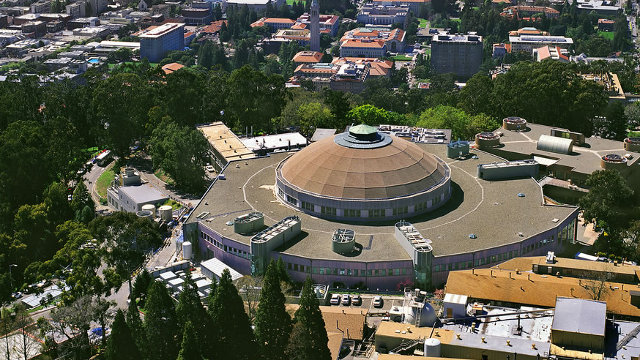"It reflects who we are as a society, a knowledge-based society," says Travis, "and this is the epitome of that."
With a staff of 4,000 and a budget of more than $800 million, the Lawrence Berkeley Lab has been overflowing its headquarters in the Berkeley Hills for some time. Research on biofuels and other fields has spilled over to satellite offices in Emeryville and Walnut Creek. The idea is to consolidate those operations into a second campus.
For several Bay Area cities, this seems like a dream opportunity.
On a blindingly sunny day in November, Alameda city development manager Jennifer Ott took me on a tour of Alameda's contender in the race: a 50-acre waterfront property in the Alameda Naval Air Station.
Gesturing to what now looks like a concrete wasteland – albeit with a spectacular Bay view – Ott described a bustling campus and waterfront promenade. Retail shops and restaurants, a jogging path.
She says when the Navy decommissioned the Air Station 15 years ago, the city lost thousands of jobs. The lab would be a chance to bring this area back to life.
So, Alameda is offering the site to the lab for free, which says a lot, especially when you consider that – as because it’s a national lab – the campus will contribute nothing in local property taxes
Ott says It’s still worth it.
"They will shop in our stores," says Ott, "eat in our restaurants. And we also believe that they will attract other private development to the area that will bring tax revenue into the city and jobs."
The need for jobs unites all six of the possible sites. But here’s something else many of them have in common: They're flat and by the water.
And that presents a problem that no one has much experience dealing with says Will Travis.
"The fact that these areas are low-lying and vulnerable to sea level rise isn't something that's been integrated into regulatory process yet."
San Francisco Bay waters are expected to rise steadily in coming years: 16 inches by 2050, up to 55 inches by the end of the century.
But the more imminent threat, says Travis, is storms.
"The scientists are telling us that we will have more extreme events more often. And we’re seeing it.
Travis believes that sea-level rise is something that can be designed around with stilts, or artificial hills, setbacks. His former agency, the BCDC is charged with writing those guidelines.
But at a certain point, says Heather Cooley, of the Oakland-based Pacific Institute, there will be places simply not worth developing. Places we will just abandon to the rising waters.
"We will need to have those sorts of conversations," says Cooley. But she adds that nobody in the Bay Area seems quite ready to have them yet.
Other hard conversations are taking place just north, near the Albany/Berkeley border at Golden Gate Fields.
On the day I visited, a thoroughbred named "I'm Tops" is getting a pedicure, his hooves filed down and shiny new aluminum shoes fitted with nails and a hammer.
"This is a dying art," said Peter Tunney, my guide and a member of the Stronach Group, the private racing firm that owns this racetrack and others.
Tunney has been in the racing business most of his adult life. But he said betting had declined in recent years. Sometime, the grandstands were only half-full.
Horse racing, said Tunney, "has become a television sport. We have all learned that we don’t need grandstands anymore."
If Lawrence Berkeley chooses this spot to put its new campus, the racetrack, built in 1941, would be torn down. The lab would either buy the property, or lease it from the Stronach Group.
Racing would continue, said Tunney, just somewhere smaller inland like Pleasanton.
"We're in the racing business. We’ll stay in the racing biz. We’re just following this through as a potential option."
If the lab chooses Albany, there will be some hurdles. Birders say the construction could damage precious habitat near the track.
And losing the track would cost the city of Albany about a million and a half tax dollars that it takes in from the track each year, money that funds its schools, among other things. By law, residents here would have the right to vote on whether to allow the lab or not, which could add time and risk to the process
There are no easy answers, says the BCDC's Will Travis. "And I think that’s what’s taking so long. We have a series of imperfect alternatives."
One final option is to build out the Richmond Field Station, off of I-580, and just north of the racetrack. The Field station, which Lawrence Berkeley Lab already owns, currently houses several scientific projects, including an earthquake simulator and UC Berkeley's Forest Products Lab.

